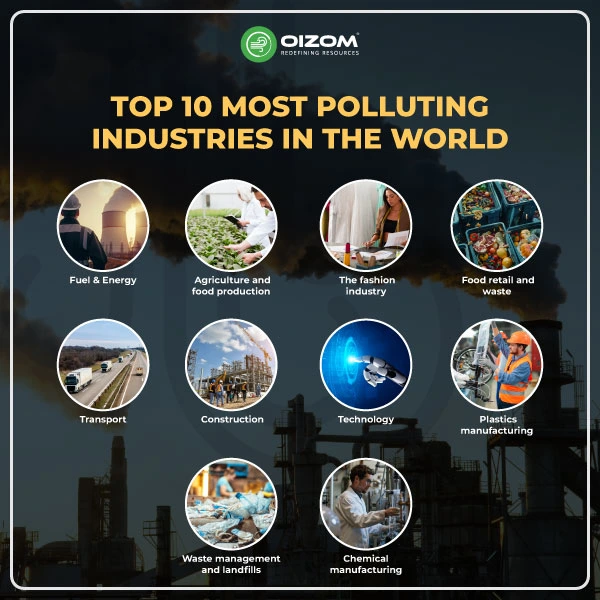10 Key Takeaway Points:
- Fuel & Energy is the top polluter, contributing to around 75% of global greenhouse gas emissions, mainly through fossil fuels like coal, gas, and oil.
- Agriculture and food production account for up to 18% of emissions, largely from livestock, land-use changes, and ammonia pollution.
- The fashion industry (especially fast fashion) is behind 8–10% of global carbon emissions, and generates massive textile waste and water pollution.
- Food retail and waste contribute significantly to emissions, with 1.9 million tonnes of food wasted annually in the UK alone, and high emissions from refrigeration and plastic packaging.
- Transport is responsible for one-fifth of global CO₂ emissions, with road vehicles being the main culprit, followed by freight and air travel.
- Construction causes 23% of air pollution, releasing dust, gases, and using energy-intensive machinery, especially in fast-growing urban areas.
- Technology, including data centers and cryptocurrency, uses huge amounts of electricity and is rapidly becoming a major emissions source.
- Plastics manufacturing pollutes the air and water, especially through burning and improper recycling, releasing toxic chemicals into the environment.
- Waste management and landfills generate around 20% of global methane emissions, a powerful greenhouse gas; smarter monitoring and waste-to-energy tech are key solutions.
- Chemical manufacturing releases VOCs, NOx, SO₂, and PM, all of which contribute to smog, acid rain, and serious health issues. Oizom’s air quality monitoring solutions help businesses and industries track emissions, monitor air quality in real-time, and take data-driven steps to reduce pollution and improve sustainability.
Top 10 Most Polluting Industries in the World
Pollution is one of the biggest threats facing our planet today. It’s affecting the air we breathe, the water we drink, and even the weather we depend on. And while it’s a shared problem, much of it starts with a few major industries.
Over the years, governments, researchers, and media have all stepped in to raise awareness. Climate change, once a distant concern, is now at the center of global action. The IPCC and other experts agree that if we want to avoid the worst impacts, we need to cut pollution fast.
But here’s the thing: pollution isn’t just about smog-filled skies or plastic in oceans. It comes from many places, some we talk about all the time, and others we often overlook. In this blog, we’ll break down the 10 most polluting industries in the world in 2025. From fossil fuels and mining to fashion and electronics, we’ll look at how each sector contributes to environmental damage, and what’s being done to change that.
If you’ve ever wondered where the real environmental impact begins, or what industries need the biggest clean-up, this is for you. Let’s get started.
How did we arrive at this list of top Polluting Industries?
Creating a clear ranking of the top polluting sectors requires extensive study and analysis of numerous environmental parameters. In creating this list, we concentrated on companies. Being ranked as the most polluting signifies that a particular industry or sector is prominent in contributing to air and water pollution, greenhouse gas emissions, and waste generation. The research was based on the most recent scientific studies and environmental data from respectable organizations such as the United Nations Environment Programme and the World Health Organization. We also assessed these industries’ global reach and impact, acknowledging that pollution is a global problem rather than a local one. The cumulative environmental footprint, from resource extraction to end-of-life disposal, was essential in determining each industry’s ranking.
Top 10 polluting industries in the World
There is no standard approach for determining the most polluting companies. As a result, we analyzed the five major types of pollution affecting the world: water, air, light, soil, and noise pollution. Visual pollution from your neighbours’ poor landscaping choices was not considered. While all types of pollution are harmful, there is little doubt that air and water pollution are the most damaging to our physical health. However, this blog will talk only about air pollution emissions from various industries. Therefore, the industrial pollution highlighted below focuses on this catastrophic type of pollution: air. This industry not only affected the nearby area but had a significant impact on the urban area as well. “How these industries contributed to a global issue by worsening the air quality of the various cities, which created the world’s top 10 most polluted cities list. Did you know that air pollution is identified as a top global risk according to the World Economic Forum.
In fact, in 2021 alone, air pollution contributed to more than 8.7 million deaths, while water pollution contributed to 1.5 million child deaths and continues to threaten sea life on a global scale.
1.) Fuel & Energy Industry - 75% of Global GHG Emissions
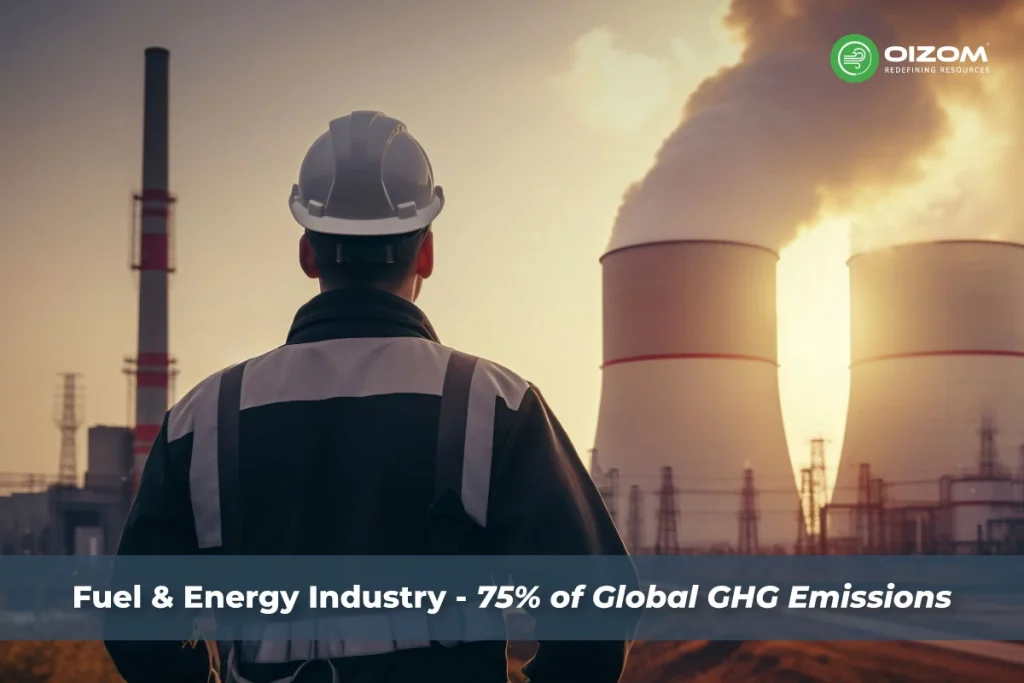
Unsurprisingly, the energy industry tops the list of most polluting sectors, and it’s still powering most of our lives.
From heating our homes to running factories and charging electric vehicles, fossil fuels like gas, coal, and oil remain central to daily life in many countries. For example, in the UK, natural gas generates nearly 50% of electricity, and about 87% of homes still rely on gas boilers for heating.
While there’s growing talk about switching to cleaner energy, the reality is: we’re not there yet. Burning fossil fuels releases large amounts of carbon dioxide, a leading cause of climate change. But it’s not just the air we’re harming. Oil spills from drilling and transportation frequently pollute oceans, poisoning fish, harming birds, and destroying marine ecosystems.
In 2021 alone, over 700 metric tonnes of oil were spilled into the environment, a stark reminder of the industry’s massive footprint.
The takeaway? As long as we continue relying on fossil fuels, both the planet and wildlife will keep paying the price. Transitioning to cleaner energy isn’t just a climate goal, it’s a necessity.
One example is the Tiroda Thermal Power Plant in Maharashtra, one of India’s largest coal-based plants. To keep pollution in check, they installed Oizom’s air quality monitors to track PM2.5, PM10, SO₂, and NO₂ in real time. This helped them follow regulations and make better decisions using accurate data. Read the full case study here
Real-time reminder: Oil spill off Kerala coast
Just recently, a cargo ship named MSC ELSA 3 sank off the coast of Kerala while sailing from Vizhinjam to Kochi. It was carrying hundreds of containers, including hazardous chemicals and over 450 tonnes of oil and fuel.
Luckily, all 24 crew members were rescued. But now, there’s a growing concern about an oil spill reaching the coastline, especially with the monsoon approaching. Oil and plastic pellets have already started washing up on beaches, threatening marine life and local livelihoods.
Authorities are working on clean-up operations, but it’s a tough job, especially once oil hits the shore. This isn’t just a headline, it’s a wake-up call.
2.) Agriculture & Food Production - 18% of Global Emissions
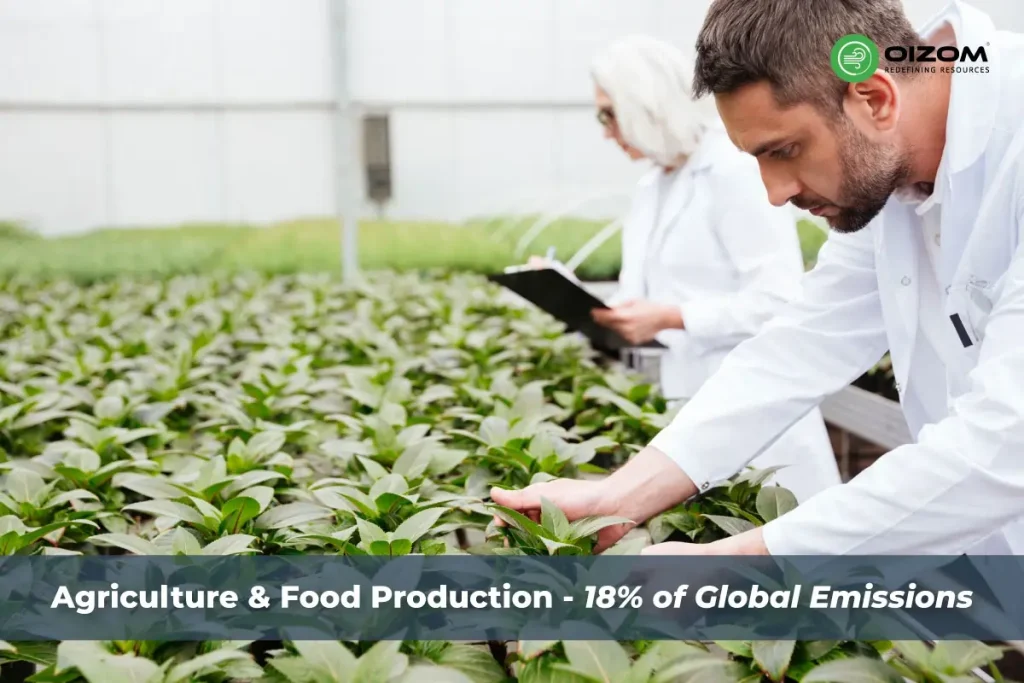
When we think about pollution, farming might not be the first thing that comes to mind, but it should be.
The agriculture and food production industry is a major contributor to environmental damage. According to the IPCC, it’s directly responsible for around 8.5% of global greenhouse gas emissions, with another 14.5% coming from land-use changes like deforestation. That’s nearly a quarter of all emissions.
One big problem? Livestock farming. Cows and other animals release large amounts of methane and nitrous oxide, both powerful greenhouse gases. Add to that the fact that 70% of the world’s freshwater goes into farming, and it’s clear how resource-heavy this industry is.
Then there’s deforestation. Forests are cleared to make way for crops or pasture, especially for high-demand industries like palm oil and cattle. In just one month in 2022, over 1,000 sq. km of the Amazon was destroyed, nearly double the area from the year before.
There’s also the issue of ammonia emissions from livestock manure and fertilizers, which are major contributors to particulate matter (PM) in the air. In European cities, ammonia from farming is behind more than half of PM-related air pollution.
Even what we eat matters. A study by Oxford University found that meat-eaters are responsible for twice as many food-related emissions as vegetarians, and even more compared to vegans.
Farming feeds the world, but it’s also feeding pollution. Cleaner practices and smarter monitoring are the way forward.
For instance, SKUAST Jammu, a university working on livestock farming, installed Oizom’s Odosense system to monitor odour levels around their facilities. With real-time data on gases like ammonia and hydrogen sulphide, they were able to track pollution patterns and take early action, helping both animal welfare and surrounding communities. It’s a small but important step in making agriculture smarter and more sustainable. Read the full case study here.
3.) Fashion Industry (Fast Fashion)

Fast fashion might look trendy, but its environmental cost is far from stylish. The fashion industry is responsible for 8–10% of global carbon emissions, that’s more than all international flights and shipping combined. And if we don’t slow it down, this number could rise by 50% by 2030.
Why is fashion so polluting? It starts with the materials. Cheap fabrics like polyester, made from fossil fuels, are widely used. Every time you wash them, they shed microplastics that end up in oceans. Then there’s the dyeing and finishing process, which pollutes 20% of the world’s clean water. Add in the fact that fashion uses about 93 billion cubic meters of water each year, and you see how quickly the damage adds up.
This is a major contributor to air pollution in textile industry, as harmful chemicals and particulate matter are released during production, dyeing, and finishing stages.
The clothes themselves don’t last long. Fast fashion thrives on short trends, low prices, and low quality. As a result, 92 million tonnes of textile waste are generated every year, and 85% of it ends up in landfills. In the UK alone, 350,000 tonnes of clothing are dumped yearly.
It doesn’t end there. Most clothes are produced in coal-powered factories, often in Asia, and shipped across the globe. In fact, postal delivery emissions in the US alone are equal to those from 7 million cars.
To make fashion truly sustainable, the industry needs to rethink how it designs, produces, and delivers. Until then, it remains one of the top polluting industries on the planet.
4.) Food Retail
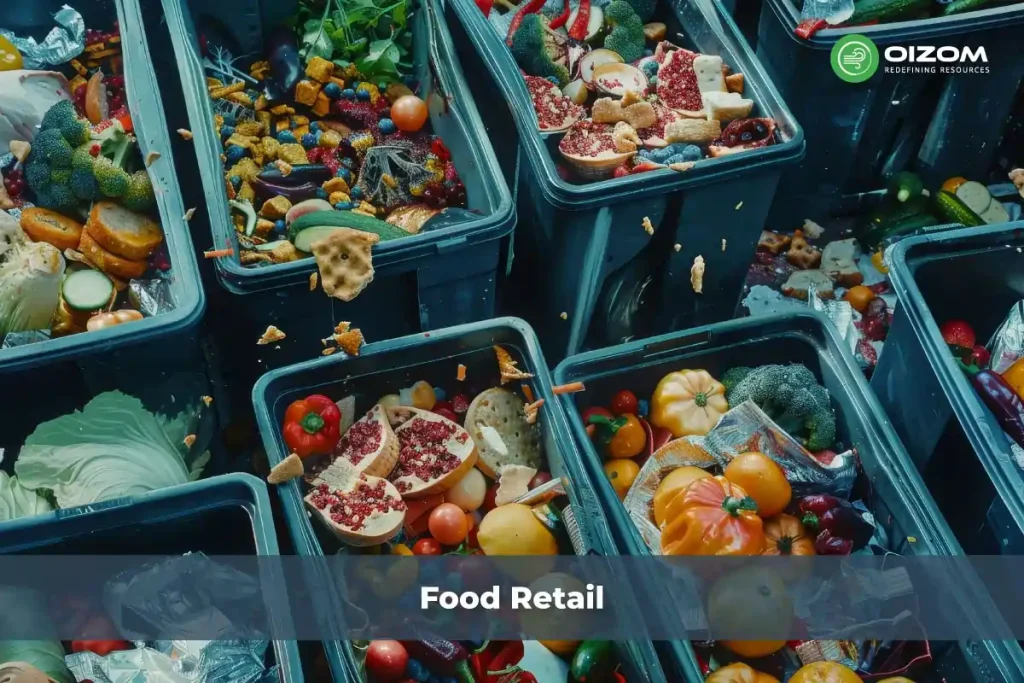
When we think of pollution in food, farming usually gets the blame. But the retail side, supermarkets, restaurants, and packaging, plays a huge role too.
As the global demand for food rises, so does the environmental cost. From plastic packaging to food waste, this sector is producing a surprising amount of pollution.
In the UK alone, about 1.9 million tonnes of food are wasted every year, a record high. That’s not just leftovers in your fridge. It’s unsold food from grocery stores, restaurants, and suppliers that gets thrown out.
Food waste is a big deal. It’s estimated to cause 8–10% of global greenhouse gas emissions. And in the EU, nearly 57 million tonnes of food are wasted annually, which comes out to 127 kg per person.
Then there’s plastic packaging. Food retailers in the UK are behind around 800,000 tonnes of plastic waste every year, enough to blanket Greater London in a 2.5 cm layer of plastic. Shocking, right?
Even running a supermarket takes a toll. The average grocery store emits nearly 3,000 metric tonnes of CO₂ each year, mostly from electricity and leaked refrigerants. And since refrigeration uses over half of their electricity, it’s a major source of energy-related emissions.
Some countries are taking action. France, for instance, banned supermarkets from throwing away edible food. Instead, they donate it to charities, cutting waste and helping people at the same time.
Food retail might look clean and convenient, but behind the scenes, it’s a heavy polluter. Reducing waste, improving energy efficiency, and rethinking packaging can make a real difference.
5.) Transport Industry - 74.5% of Transport CO₂ Emissions from Road Vehicles
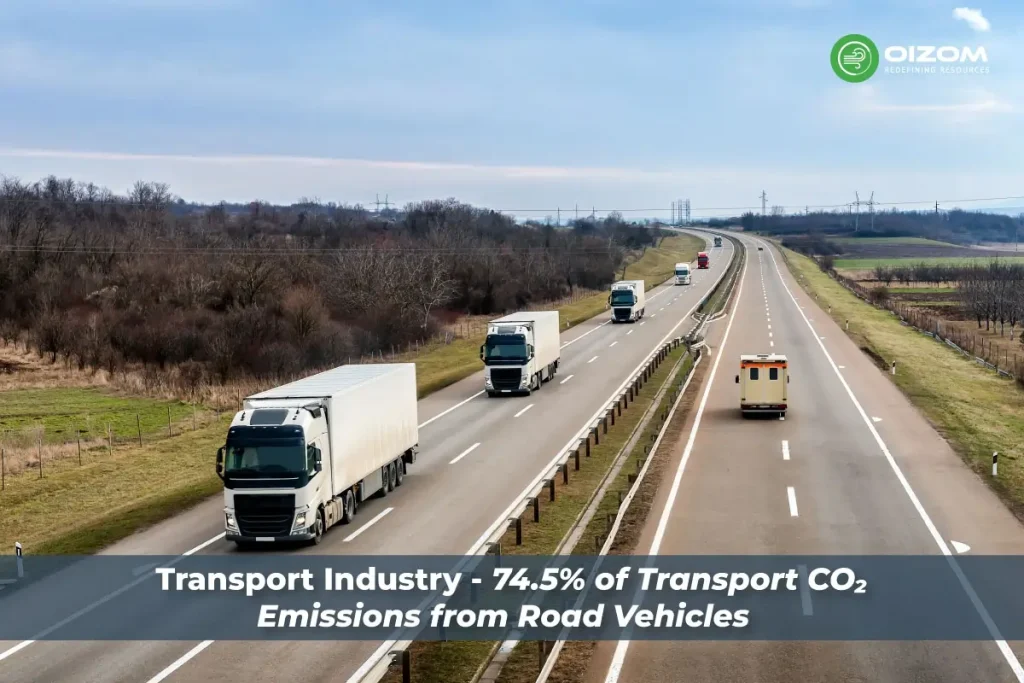
Transport is something we all rely on, but it’s also a major contributor to global carbon emissions, responsible for about one-fifth of the world’s CO₂ output.
When we break it down, 60% comes from passenger travel (cars, bikes, buses), and 40% from freight and logistics. While air travel often gets the spotlight for pollution, cars are actually the bigger problem, mostly because so many more people use them every day. This highlights the growing importance of air quality monitoring solutions for the automotive industry, which help track vehicle emissions and support the shift toward cleaner mobility.
In fact, in places like the UK, over 70% of the population owns a car, and each one emits around 4.6 metric tonnes of CO₂ every year. That adds up fast.
Air travel has grown by nearly 40% since 2010, and while planes are getting quieter, they still emit a lot of carbon, about 16% of transport emissions come from flying. But compared to the sheer number of cars on the road, flights are a smaller piece of the puzzle.
It’s not just personal travel. Commercial freight, trucks, ships, planes, plays a huge role too. Shipping alone is expected to contribute up to 17% of global CO₂ emissions by 2050 if trends continue.
The takeaway? Whether it’s your daily commute, online shopping delivery, or a global supply chain, transport emissions are everywhere. To make a real impact, we need better public transport, cleaner fuels, smarter logistics, and a serious shift in how we move goods and people around the world. Did you want “Solutions for improving air quality on roads and highways in the transport industry by monitoring how much the transport industry emits pollutants?
6.) Construction - 23% of Global Air Pollution
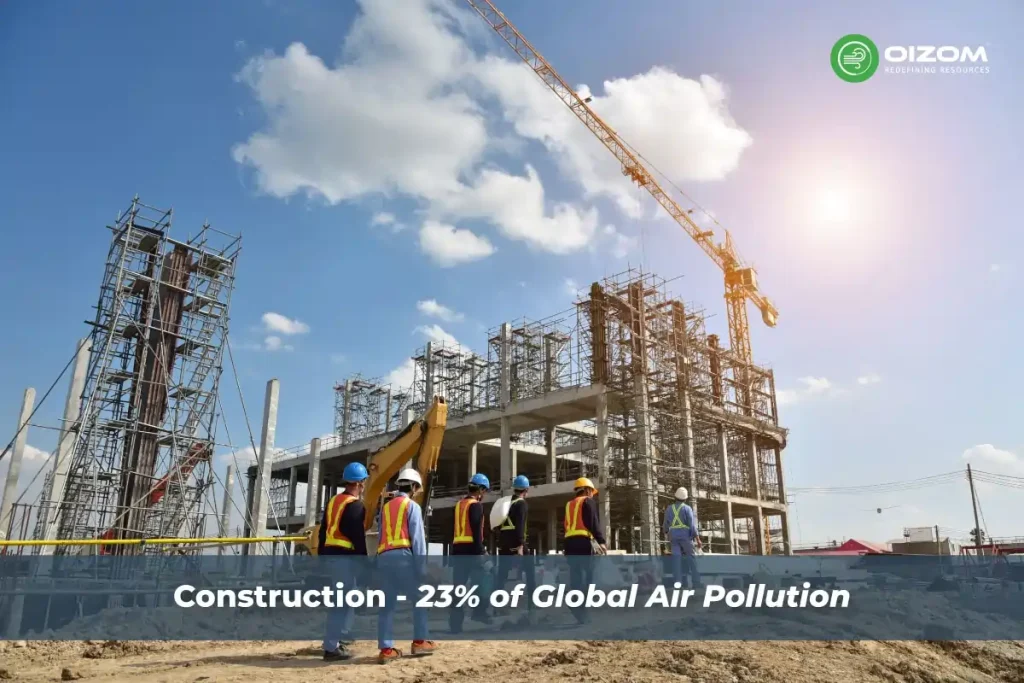
One important but frequently disregarded factor contributing to India’s declining air quality is the construction industry. Examining the connection between air pollution and construction. We live in an age where the expansion of cities and the construction of infrastructure are synonymous with progress. Construction and demolition activities worsen air quality in three key ways:
- Dust Pollution: Machinery movement, demolition, and material handling release fine dust (PM10, PM2.5, PM1), posing health risks, especially to vulnerable groups.
- Machinery Emissions: Construction equipment emits dust, noise, and harmful gases like NOx and CO.
- Material Transport: Moving and handling construction materials further increases dust and air pollution.
- Minimizing dust control measures and using low-emission equipment can help reduce the impact.
Did you know this? According to new research by construction blog Bimhow, the construction sector contributes to 23% of air pollution, 50% of the climatic change, 40% of drinking water pollution, and 50% of landfill wastes. In separate research by the U.S. Green Building Council (USGBC), the construction industry accounts for 40% of worldwide energy usage, with estimations that by 2030 emissions from commercial buildings will grow by 1.8%.
If you live in a city, sometimes it’s easy to forget that construction work isn’t part of natural life. This industry contributes to almost all types of pollution – air, water, soil, light, and we’re all familiar with the noise pollution it creates – and it’s happening almost everywhere worldwide. Buildings are projected to release approximately 40% of global emissions after accounting for the extraction and transportation of building materials, construction processes, and day-to-day activities. To help the construction industry achieve net-zero emissions, it is critical to investigate options such as using more sustainable materials and practices, increasing energy efficiency, offsetting residual emissions, and monitoring air quality levels at construction sites with automated dust suppression techniques can be more effective.
7.) Technology - 200-250 TWh Electricity Use in 2023

Technology has changed our lives for the better, no doubt about that. From renewable energy systems to smart homes, it’s helping us live more efficiently. But behind the scenes, it’s also becoming one of the fastest-growing sources of pollution.
Think about it, everything we do today runs on tech. Phones, laptops, streaming, transport, even work meetings. All of it requires energy. A decade ago, turning off standby TVs felt like a good step. Today, with devices everywhere and always on, we need much bigger changes.
One of the biggest hidden energy users? Data centers. These are the backbone of the internet, powering everything from Google searches to cloud storage. In 2023 alone, data centers consumed around 200–250 terawatt-hours of electricity, about 1–1.3% of the world’s total power use.
Big tech companies like Amazon, Microsoft, Google, and Meta have more than doubled their energy use since 2017, hitting 72 TWh by 2021. And as demand for AI, 5G, virtual reality, and blockchain grows, so does their electricity bill.
Then there’s cryptocurrency. Digital currencies like Bitcoin might be virtual, but their environmental impact is very real. Crypto mining emits about 129 million tonnes of CO₂ a year, that’s more than the entire country of Qatar, and it uses more electricity than Egypt.
So while tech is helping us in many ways, it’s also raising new challenges. The key is using it smarter, not just more.
8.) Plastics Manufacturing

Plastic and Its Impact on Air Quality
Plastics come from fossil fuels like oil and gas, which release harmful pollutants during extraction. Drilling emits toxic chemicals like benzene, carbon monoxide, and sulfur dioxide, contributing to air pollution.
- Recycling Challenges: Recycling helps reduce plastic waste, but if not done properly, it can still harm the environment and workers.
- Burning Plastic = Toxic Air: Since plastic takes a long time to break down, much of it is burned, releasing heavy metals and toxic pollutants into the air.
- What Can We Do?: Until we have better alternatives, the best solution is to reduce plastic use and keep it out of landfills and oceans.
As for packaging emissions, research suggests that 800,000 tonnes of plastic waste a year come from UK food retailers alone – enough waste to cover the whole of Greater London to a depth of 2.5 cm.
9.) Waste Management and Disposal - Landfills Cause 20% of Methane Emissions
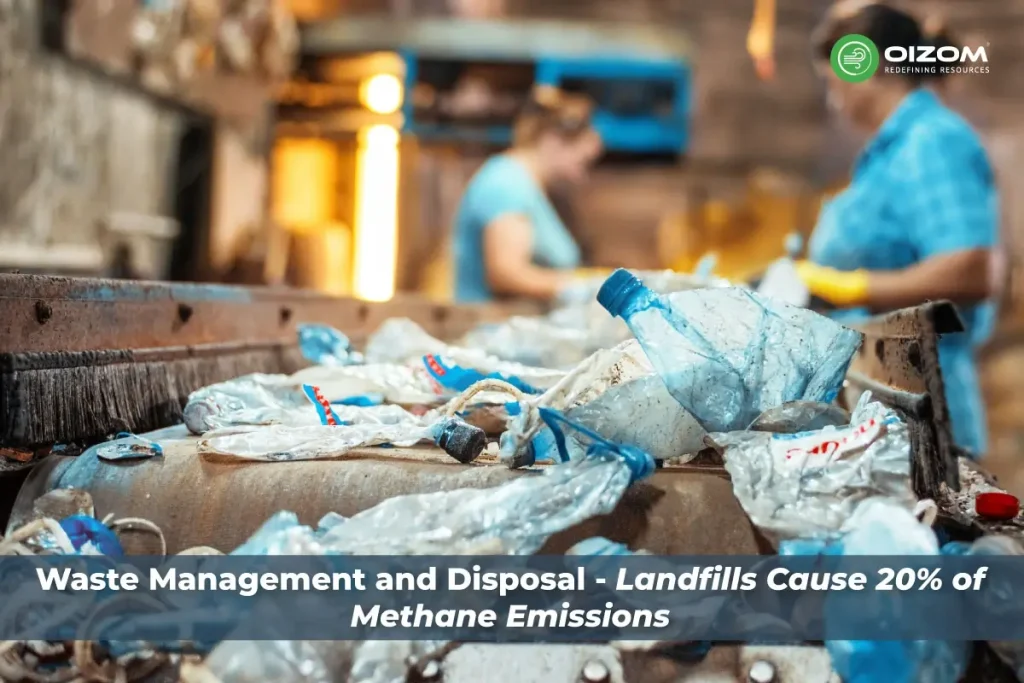
Poor waste management doesn’t just create eyesores, it seriously harms the environment. In many parts of the world, overflowing landfills are polluting our soil, water, and air, especially where waste systems are outdated or lacking.
But here’s something most people don’t realize: landfills are responsible for about 20% of global methane emissions. And methane is no small player, it’s a greenhouse gas up to 80 times more powerful than CO₂ over the short term.
Thankfully, there are smarter solutions emerging. Technologies like anaerobic digestion and biodegradation can turn waste into biofuels, liquid or gas energy sources that are far cleaner than fossil fuels. At the same time, adopting practices like air quality monitoring in waste management facilities plays a vital role in reducing emissions and safeguarding nearby communities.
And it’s not just about managing waste, it’s about preventing it too. One way is to replace plastics and other high-emission materials with more eco-friendly options. Think wood, paper-based packaging, or even seaweed-based alternatives. These materials break down faster, are easier to recycle, and come from renewable sources, as long as forests and resources are managed responsibly.
Better waste handling isn’t just a clean-up job. It’s a climate solution we urgently need.
In fact, some landfill sites are now taking a more data-driven approach to environmental management. For example, at the VAATC landfill in Vietnam, real-time air quality monitors were installed to track gases like methane, ammonia, and hydrogen sulfide. This helped the operators identify pollution hotspots, improve ventilation, and take timely action to reduce odour and gas build-up. It’s a practical example of how better monitoring can lead to better outcomes, for both the environment and nearby communities. Read the full case study here.
10.) Chemical Manufacturing - Major VOC, NOx, SO₂ Pollutant
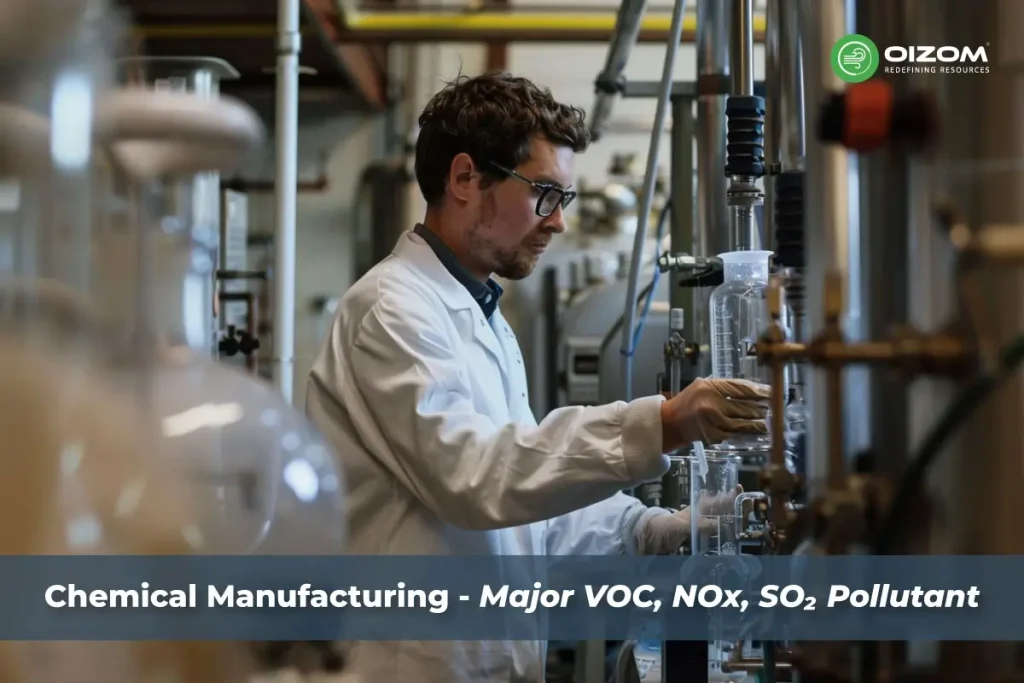
Chemical manufacturing industries are known for emitting air pollutants with significant environmental and health impacts. Key pollutants include:
- Volatile Organic Compounds (VOCs): These are emitted during the production and use of solvents, paints, and other chemicals. VOCs contribute to ground-level ozone and smog formation, posing risks to respiratory health.
- Nitrogen Oxides (NOx): Generated during high-temperature combustion processes, NOx gases are precursors to ozone and particulate matter, aggravating respiratory conditions and contributing to acid rain.
- Sulfur Dioxide (SO2): Released from the burning of fossil fuels containing sulfur, SO2 can lead to acid rain, which harms ecosystems and corrodes buildings.
- Particulate Matter (PM): These tiny particles can arise from chemical reactions and combustion. PM is a significant concern due to its ability to penetrate deep into the lungs, causing respiratory and cardiovascular issues.
Want to know how the Mitsubishi chemical plant in the USA monitors air quality with Oizom’s Odosense to protect workers’ health and meet environmental regulations? Then, you can read our case study.
Conclusion
So there you have it, the industries contributing most to pollution. These sectors release a wide range of harmful emissions, including both primary and secondary pollutants, which significantly degrade air and environmental quality. Tackling this won’t be easy, but progress is already underway. We’re seeing more electric vehicles, renewable energy adoption, and a growing shift toward sustainable choices like plant-based diets and plastic-free living.
Industries have a big role to play, and tools like Oizom’s real-time air quality monitoring systems are helping them take action. By tracking pollutants and making data-driven decisions, companies can reduce their impact and move toward cleaner operations.
It’s easy to feel overwhelmed, but there’s reason to be hopeful. With the right tech, policies, and mindset, a more sustainable future isn’t just possible, it’s already taking shape. Let’s keep pushing forward.
FAQs
The most polluting industries include fuel and energy, agriculture, fashion, food retail, transport, construction, technology, plastics, waste management, and chemical manufacturing.
The fuel and energy industry is the largest contributor to air pollution, responsible for about 75% of global greenhouse gas emissions.
Fast fashion causes pollution through textile waste, synthetic fabric microplastics, and heavy water and energy use in manufacturing and transport.
Poor waste management leads to methane emissions, air and water pollution, and health risks. Smart monitoring and eco-friendly disposal methods can reduce the impact.
Industries can reduce pollution by using real-time air quality monitoring systems, switching to clean energy, improving efficiency, and adopting sustainable practices

